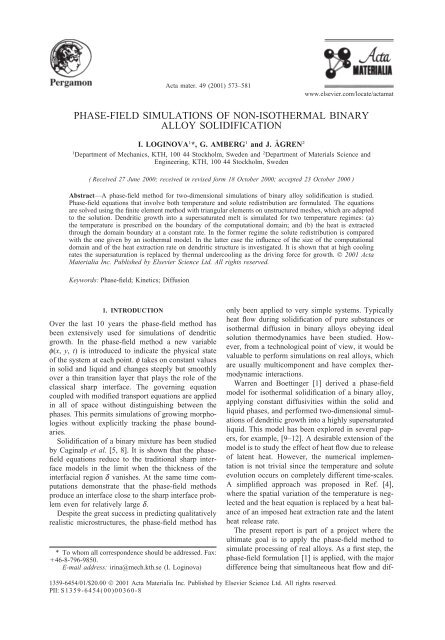Phase-field modeling of diffusion controlled phase ... - KTH Mechanics
Phase-field modeling of diffusion controlled phase ... - KTH Mechanics
Phase-field modeling of diffusion controlled phase ... - KTH Mechanics
You also want an ePaper? Increase the reach of your titles
YUMPU automatically turns print PDFs into web optimized ePapers that Google loves.
Acta mater. 49 (2001) 573–581www.elsevier.com/locate/actamatPHASE-FIELD SIMULATIONS OF NON-ISOTHERMAL BINARYALLOY SOLIDIFICATIONI. LOGINOVA 1 *, G. AMBERG 1 and J. ÅGREN 21Department <strong>of</strong> <strong>Mechanics</strong>, <strong>KTH</strong>, 100 44 Stockholm, Sweden and 2 Department <strong>of</strong> Materials Science andEngineering, <strong>KTH</strong>, 100 44 Stockholm, Sweden( Received 27 June 2000; received in revised form 18 October 2000; accepted 23 October 2000 )Abstract—A <strong>phase</strong>-<strong>field</strong> method for two-dimensional simulations <strong>of</strong> binary alloy solidification is studied.<strong>Phase</strong>-<strong>field</strong> equations that involve both temperature and solute redistribution are formulated. The equationsare solved using the finite element method with triangular elements on unstructured meshes, which are adaptedto the solution. Dendritic growth into a supersaturated melt is simulated for two temperature regimes: (a)the temperature is prescribed on the boundary <strong>of</strong> the computational domain; and (b) the heat is extractedthrough the domain boundary at a constant rate. In the former regime the solute redistribution is comparedwith the one given by an isothermal model. In the latter case the influence <strong>of</strong> the size <strong>of</strong> the computationaldomain and <strong>of</strong> the heat extraction rate on dendritic structure is investigated. It is shown that at high coolingrates the supersaturation is replaced by thermal undercooling as the driving force for growth. © 2001 ActaMaterialia Inc. Published by Elsevier Science Ltd. All rights reserved.Keywords: <strong>Phase</strong>-<strong>field</strong>; Kinetics; Diffusion1. INTRODUCTIONOver the last 10 years the <strong>phase</strong>-<strong>field</strong> method hasbeen extensively used for simulations <strong>of</strong> dendriticgrowth. In the <strong>phase</strong>-<strong>field</strong> method a new variablef(x, y, t) is introduced to indicate the physical state<strong>of</strong> the system at each point. f takes on constant valuesin solid and liquid and changes steeply but smoothlyover a thin transition layer that plays the role <strong>of</strong> theclassical sharp interface. The governing equationcoupled with modified transport equations are appliedin all <strong>of</strong> space without distinguishing between the<strong>phase</strong>s. This permits simulations <strong>of</strong> growing morphologieswithout explicitly tracking the <strong>phase</strong> boundaries.Solidification <strong>of</strong> a binary mixture has been studiedby Caginalp et al. [5, 8]. It is shown that the <strong>phase</strong><strong>field</strong>equations reduce to the traditional sharp interfacemodels in the limit when the thickness <strong>of</strong> theinterfacial region d vanishes. At the same time computationsdemonstrate that the <strong>phase</strong>-<strong>field</strong> methodsproduce an interface close to the sharp interface problemeven for relatively large d.Despite the great success in predicting qualitativelyrealistic microstructures, the <strong>phase</strong>-<strong>field</strong> method has* To whom all correspondence should be addressed. Fax:46-8-796-9850.E-mail address: irina@mech.kth.se (I. Loginova)only been applied to very simple systems. Typicallyheat flow during solidification <strong>of</strong> pure substances orisothermal <strong>diffusion</strong> in binary alloys obeying idealsolution thermodynamics have been studied. However,from a technological point <strong>of</strong> view, it would bevaluable to perform simulations on real alloys, whichare usually multicomponent and have complex thermodynamicinteractions.Warren and Boettinger [1] derived a <strong>phase</strong>-<strong>field</strong>model for isothermal solidification <strong>of</strong> a binary alloy,applying constant diffusivities within the solid andliquid <strong>phase</strong>s, and performed two-dimensional simulations<strong>of</strong> dendritic growth into a highly supersaturatedliquid. This model has been explored in several papers,for example, [9–12]. A desirable extension <strong>of</strong> themodel is to study the effect <strong>of</strong> heat flow due to release<strong>of</strong> latent heat. However, the numerical implementationis not trivial since the temperature and soluteevolution occurs on completely different time-scales.A simplified approach was proposed in Ref. [4],where the spatial variation <strong>of</strong> the temperature is neglectedand the heat equation is replaced by a heat balance<strong>of</strong> an imposed heat extraction rate and the latentheat release rate.The present report is part <strong>of</strong> a project where theultimate goal is to apply the <strong>phase</strong>-<strong>field</strong> method tosimulate processing <strong>of</strong> real alloys. As a first step, the<strong>phase</strong>-<strong>field</strong> formulation [1] is applied, with the majordifference being that simultaneous heat flow and dif-1359-6454/01/$20.00 © 2001 Acta Materialia Inc. Published by Elsevier Science Ltd. All rights reserved.PII: S13 59-6454(00)00360-8
















